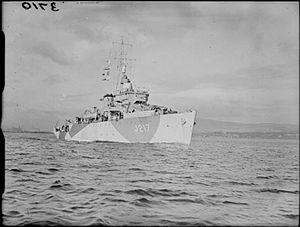HMS Loyalty (J217) facts for kids
 |
|
Quick facts for kids History |
|
|---|---|
| Name |
|
| Builder | Harland and Wolff, Belfast |
| Yard number | 1142 |
| Laid down | 14 April 1941 |
| Launched | 9 December 1942 |
| Completed | 22 April 1943 |
| Commissioned | 22 April 1943 |
| Identification | Pennant number J217 |
| Motto | "Fight for the King" |
| Honours and awards |
Normandy 1944 |
| Fate | Sunk on 22 August 1944 by U-480 |
| Badge | On a Field barry wavy of six White and Blue, a sprig of three oak leaves, Gold |
| General characteristics | |
| Class and type | Algerine-class minesweeper |
| Displacement | 850 tons |
| Length | 225 ft (69 m) |
| Beam | 35 ft 6 in (10.82 m) |
| Propulsion |
|
| Complement | 85 men |
| Armament |
|
HMS Loyalty was a special kind of ship called a minesweeper that used steam turbines to move. She was part of the Royal Navy during World War II. Before she was named Loyalty, her name was HMS Rattler.
She started serving in 1943. Loyalty played an important role during the Allied attack on Normandy in 1944. While she was working near the coast, a German submarine attacked her with a torpedo, and she sank.
Contents
What Was HMS Loyalty Like?
How Big Was the Ship?
HMS Loyalty was part of the Algerine class of minesweepers. These ships were designed to be strong and efficient.
- She weighed about 850 tons when empty.
- The ship was about 225 feet (68.6 meters) long.
- Her width, or beam, was about 35 feet 6 inches (10.8 meters).
- The ship needed 85 officers and sailors to operate it.
How Did the Ship Move?
Loyalty used two Parsons steam turbine engines. These engines worked by using steam from two large boilers.
- The engines produced a total of 2,000 horsepower.
- This power allowed the ship to reach a top speed of 16.5 knots (about 19 miles per hour).
- She could travel about 5,000 nautical miles (9,260 kilometers) without needing to refuel.
What Weapons Did HMS Loyalty Have?
The Algerine class ships were armed to defend themselves and clear mines.
- They had one 4-inch (102 mm) anti-aircraft gun. This gun was used to shoot down enemy planes.
- They also had four 20 mm Oerlikon 20 mm cannons. These were smaller guns used for close-range defense.
- The ships could also carry depth charges to attack enemy submarines.
HMS Loyalty's Journey and Missions
Building and Early Days
Rattler was started on 14 April 1941 at Harland and Wolff in Belfast. She was officially launched into the water on 9 December 1942. The ship began active service on 22 April 1943.
- The town of Ripley in North Yorkshire helped pay for the ship through a special savings campaign in March 1942.
- In June 1943, she joined the 18th Minesweeping Flotilla and was renamed Loyalty.
Minesweeping Operations
Loyalty and her flotilla (a group of ships) worked to clear mines in different areas.
- They swept mines in Lyme Bay and the English Channel.
- In August, they moved to Harwich to clear mines in the North Sea.
- Soon after, she joined the 9th Flotilla near Dover.
Operation Starkey
On 25 August, Loyalty took part in Operation Starkey. This was a plan to make German aircraft come out by doing unusual minesweeping near the French coast.
- The ships faced fire from shore batteries.
- Another ship, Hydra, was damaged.
- When they returned to Dover, British shore batteries accidentally fired on them, causing more damage.
- Loyalty could not return to minesweeping until October.
Later Missions and Normandy Landings
In November, Loyalty moved to Scapa Flow to join the 15th Minesweeping Flotilla.
- In December, she moved again to the Orkney and Shetland Command.
- She patrolled for submarines and escorted convoys (groups of ships) near Seidisfjord.
- In March 1944, she was sent back to the UK.
- In April, she had repairs in Portsmouth.
- After repairs, she joined Force G to help with minesweeping for the Allied landings in Normandy.
D-Day Support
Loyalty spent May practicing for the landings. She also helped her sister ship Stormcloud after it was damaged by a mine.
- On 6 June, Loyalty took part in the D-Day assault.
- She helped clear Channel 6 for other ships.
- She stayed near Gold Beach to protect the operations.
- Throughout July, she continued to clear mines in the anchorages (safe places for ships to stop) off Normandy.
The Sinking of HMS Loyalty
On 22 August 1944, Loyalty was still off the coast of Normandy. She was returning to Portsmouth with other minesweepers: Ready, Hound, Hydra, and Rattlesnake.
- During the journey, the sweep wires (used for minesweeping) broke.
- Loyalty and a minesweeping trawler called Doon were sent to get the wires back.
- While they were doing this, the German U-boat U-480 attacked Loyalty.
- The U-boat fired a torpedo, and Loyalty sank in less than seven minutes.
- The ship's captain and 18 sailors lost their lives.
- However, 30 people survived the attack.
- Another ship, Tanganyika, took Loyalty's place in the flotilla.
- The place where Loyalty sank is now a "protected place" under the Protection of Military Remains Act 1986. This means it is protected as a war grave.

